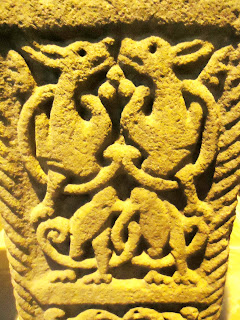Any British folklorist out there have usually read the
history of the maypole, and indeed even pagans usually like to read about the
history of the festivals they love to celebrate. Most of the information here
may be knowledge that a lot of people already know, but as the maypole is a
large feature of the Mount Franklin Annual Pagan Gathering, it’s a good idea to
write about maypole history, just in case someone out there doesn’t know.
According to J. G Frazer, it all starts with the worshipping
of trees. Centuries ago, Europe and Britain Germany
As trees were a symbol of fertility, the trees were
worshipped by women who desired to be mothers. This occurred in the East as
well as Europe – the maypole supposedly
possessed similar powers over both women and cattle. During the late spring and
summer months, maypoles were cut from the forest and blossoming branches were
strung around the house entrances. The reason for this was that the people
welcomed the blessings of the tree-spirit and its power.
According to C.A Burland, it is linked to phallic worship.
The maypole represented the phallus of the fertility god. This is why the
maypole is surrounded by dancing couples, and why May Day festivities are
associated with couple love-making in the forests overnight. Burland suggests
that it is possible that the maypole, as a phallus symbol, came over from Europe with the Anglo-Saxons. Ronald Hutton mentions that
the Saxons worshipped the pillar Irminsul, but there is no evidence that the
maypole was a reflection of it.
According to Kondratiev, the maypole is linked to the
Hawthorn Giant’s role as fertiliser of Fomorian nature – a cut tree is the
‘castration’ of the Giant, without the loss of potency – and revered in the
Celtic tribes. Its magic is passed on to those who dance around it. Cerne
Abbas, the hill giant of Dorset, is also supposedly connected to this phallic
worship, as was many standing stones.
According to Cooper, the maypole goes back to the Phrygian
pine tree of Attis, taken in procession to the temple
of Cybele , coming from Rome into Europe, then Britain
Whatever theories Frazer, Burland, Kondratiev and Cooper
have, today May Day is all about green boughs, blossoms, branches of hawthorn
and other greenery bordering doorways and shrines, and the maypole itself. It
almost does not matter what origin the maypole was – it’s quintessentially
pagan. The May Queen is usually seen parading with maypoles – her retinue of
girls often carrying small maypoles garlanded with flowers. Maypoles were decorated each spring, on display on the village
green all year, in some villages on May Day it was replaced. Each village,
country and people had its own annual tradition of maypole celebration. The
maypole was often the target of raids by rival villages – people seemed to know
how to strike at the heart of other people. In the 1500s, maypoles were well
documented in Britain
On the Eve of St John
(Midsummer) in Stockholm, thousands of maypoles from 6 inches to 12 foot high
decorated with leaves, flowers, slips of coloured paper, gilt egg shells strung
on reeds are for sale. This pole consisted of a straight and tall space pine
tree, stripped of its branches. Hoops and wood placed crosswise are attached to
it and decorated with foliage and ribbons (above).
 The largest maypole in
The largest maypole in
The Mount Franklin Pagan Gathering turned 30 in 2011,
yet it's maypole is younger than that, believed to be 20+ years old. A bicycle wheel
adorns the top and green and red ribbons - 8 each – are unravelled just before
the pagans dance with it again. Every Sunday morning at Mount Franklin Beltane,
before the pole is erected, the bicycle wheel is covered with Hawthorn blossoms
(if it’s flowering) and pink roses (if they’re flowering) from the Mountain
side.
Since 2004, the maypole song from ‘The Wicker Man’ has been
sung during the dance. Often, afterwards, depending on the success of the dance
and the pattern of the ribbons, someone with the talent foretells the future 12
months, from the pattern the ribbons made. Whatever the maypoles history, we want
this tradition to continue at MFAPG, and I am certain most of you will agree.
Books referred to:
Alexander, Marc. ‘A
Companion to the Folklore, Myths and Customs of Britain’, Sutton Publishing
Ltd, 2002.
Bord, Janet & Colin. ‘Dictionary of Earth Mysteries’, Thorsons, 1996.
Burland. C.A. ‘Echoes of Magic: A Study of Seasonal Festivals through the Ages’, Peter Davies, 1972
Cooper, J. C. ‘The Dictionary of Festivals’, Aquarian Press, 1990
Dalesman Magazines – March 1999 & April 1996
Frazer, J.G. ‘The Golden Bough’, Macmillon Press, 1922.
Hutton, Ronald. ‘The Rise and Fall of Merry England’, Oxford University Press, 1994.
Hutton, Ronald. ‘Stations of the Sun’, Oxford University Press, 1996.
Judge, Roy. ‘The Jack-In-The-Green’, The Folklore Society, 1979.
Kondratiev, Alexei. ‘The Apple Branch: A Path to Celtic Ritual’, Collins Press, 1998.
Matthews, John. ‘The Summer Solstice’, Godsfield Press, 2002.
Pegg, Bob. ‘Rites and Riots’, Blandford Press, 1981.
Bord, Janet & Colin. ‘Dictionary of Earth Mysteries’, Thorsons, 1996.
Burland. C.A. ‘Echoes of Magic: A Study of Seasonal Festivals through the Ages’, Peter Davies, 1972
Cooper, J. C. ‘The Dictionary of Festivals’, Aquarian Press, 1990
Dalesman Magazines – March 1999 & April 1996
Frazer, J.G. ‘The Golden Bough’, Macmillon Press, 1922.
Hutton, Ronald. ‘The Rise and Fall of Merry England’, Oxford University Press, 1994.
Hutton, Ronald. ‘Stations of the Sun’, Oxford University Press, 1996.
Judge, Roy. ‘The Jack-In-The-Green’, The Folklore Society, 1979.
Kondratiev, Alexei. ‘The Apple Branch: A Path to Celtic Ritual’, Collins Press, 1998.
Matthews, John. ‘The Summer Solstice’, Godsfield Press, 2002.
Pegg, Bob. ‘Rites and Riots’, Blandford Press, 1981.

























































